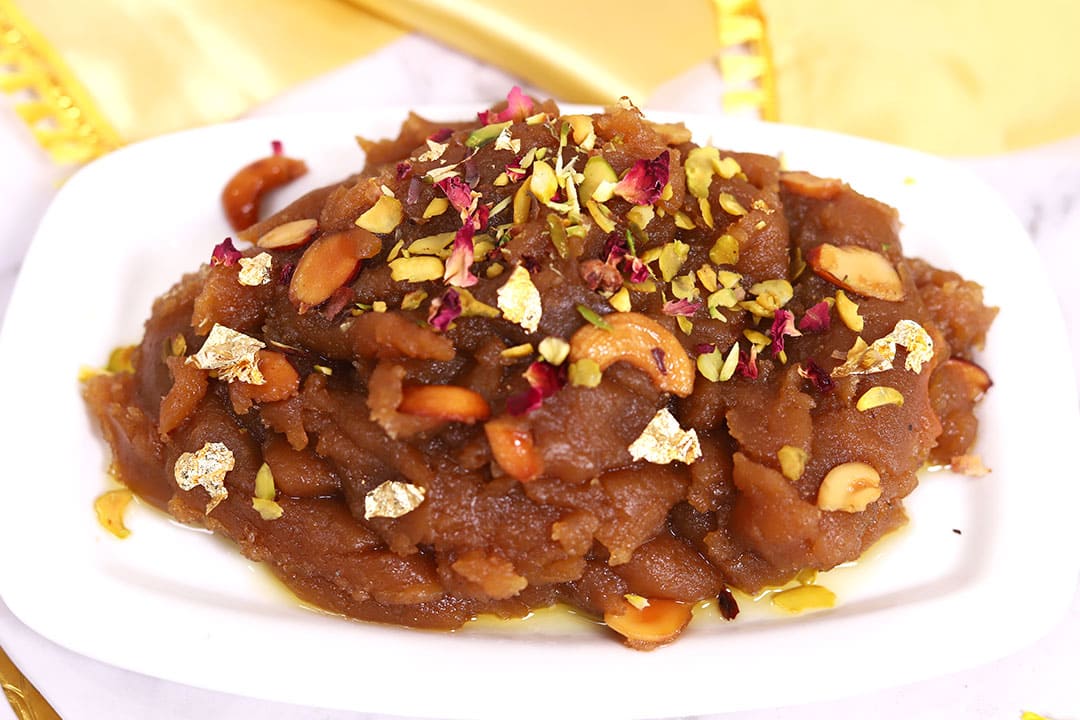Wah, Guru! Kada Prasad: A Sweet Blessing From My Kitchen to Yours!
Sat Sri Akal, Mere Pyaare Doston! (Greetings to all my dear friends!) Chef Curry Do-Pyaza here, back with another recipe that’s as soul-satisfying as a warm hug on a chilly Delhi evening. Today, we’re diving into the golden, ghee-laden goodness of Kada Prasad!
This isn’t just a sweet treat; it’s a sacred offering, a symbol of humility and devotion, and a taste of pure bliss.
When Do We Relish This Divine Delicacy?
Kada Prasad holds a special place in the hearts of Sikhs and is an integral part of their religious ceremonies. You’ll find it being lovingly prepared and distributed at Gurudwaras (Sikh temples) after prayers. It’s a must-have at celebrations like Gurpurabs (birth anniversaries of Sikh Gurus), Vaisakhi (harvest festival), and even weddings. It’s a delicious way to start any auspicious occasion. Think of it as sunshine in a bowl, perfect for any time you need a little extra warmth and sweetness in your life.
A Glimpse into History
The history of Kada Prasad is deeply intertwined with the Sikh faith. It is believed that Guru Nanak Dev Ji, the founder of Sikhism, emphasized the importance of sharing and equality. Kada Prasad, prepared with equal portions of wheat flour, sugar, and ghee, symbolizes this very principle. It’s a reminder that everyone is equal in the eyes of the divine.
Let’s Get Cooking!
This recipe is surprisingly simple, but the key is patience and a whole lot of love.
Prep Time: 5 minutes
Cooking Time: 20-25 minutes
Ingredients – The Holy Trinity (in equal measure):
- Atta (Whole Wheat Flour): 1 cup – the heart of our Prasad, giving it that earthy, wholesome flavor.
- Cheeni (Sugar): 1 cup – for that irresistible sweetness that makes you smile from ear to ear.
- Ghee (Clarified Butter): 1 cup – the soul of Kada Prasad, lending it a rich, aromatic depth.
- Pani (Water): 3 cups – Hydration for the ingredients to make it a smooth, divine offering
Step-by-Step Instructions:
- Melt the Ghee: In a heavy-bottomed kadhai (wok) or a large pan, melt the ghee over medium heat. Let it shimmer and release its nutty fragrance.
- Roast the Flour: Add the atta (whole wheat flour) to the melted ghee. Now, this is where the magic happens! Keep stirring continuously with a sturdy spatula. Be patient! At first, it will seem dry, but as you keep roasting, the ghee will incorporate into the flour.
- The Color Change: Continue roasting the flour, stirring constantly, until it turns a beautiful golden-brown color, like the setting sun over the Punjab fields. This will take about 15-20 minutes. You’ll also notice a lovely, nutty aroma filling your kitchen. Be careful not to burn the flour!
- Boil the Water: While the flour is roasting, in a separate saucepan, bring the water to a rolling boil. Add the sugar to the boiling water and stir until it dissolves completely. This creates a sugar syrup.
- The Grand Finale: Once the flour is perfectly roasted, slowly and carefully pour the hot sugar syrup into the kadhai. Be prepared for some sputtering – that’s normal! Keep stirring vigorously and continuously.
- Stir, Stir, Stir!: The mixture will quickly thicken and come together. Continue stirring until the Kada Prasad starts to leave the sides of the pan and forms a soft, glossy mass. This usually takes about 5-7 minutes. The texture should be smooth and almost pudding-like.
- Serve with Love: Your Kada Prasad is ready! Serve it hot in small bowls with reverence and a generous heart.
Chef Curry’s Tips for the Perfect Kada Prasad:
- Patience is Key: Don’t rush the roasting process. The perfect golden-brown color is crucial for the flavor and texture.
- Continuous Stirring: Stirring constantly prevents the flour from burning and ensures a smooth, even texture.
- Quality Ingredients: Use good quality ghee for the best flavor. Fresh atta also makes a difference.
- Consistency: The consistency should be smooth and almost pudding-like. If it’s too dry, add a splash of hot water. If it’s too runny, cook it for a few more minutes.
Cooking it Your Way:
- Gas Stove: The traditional method, and my personal favorite. Just keep the heat at medium and stir, stir, stir!
- Induction Stove: Works perfectly well. Just adjust the heat settings as needed.
- Pressure Cooker: Not recommended for Kada Prasad. It’s all about the slow roasting.
- Oven: You can try roasting the flour in the oven at a low temperature (around 300°F or 150°C), stirring occasionally, but it won’t be quite the same.
- Microwave: Not recommended. It’s difficult to control the cooking process and achieve the desired texture.
- Air Fryer: I haven’t tried this myself, but I suspect it wouldn’t work well for this recipe.
- Slow Cooker/Crockpot: Definitely not suitable for Kada Prasad.
Nutritional Information (Approximate, per serving):
- Calories: 350-400
- Fat: 25-30g
- Carbohydrates: 30-35g
- Protein: 3-4g
Serving Suggestions:
- Serve hot immediately after preparation.
- Offer it as a prasad (blessed food) after prayers.
- Enjoy it as a sweet treat on a cold day.
- Share it with your loved ones.
A Humble Request:
Friends, I urge you to try this recipe at home. Feel the warmth of the ghee, the sweetness of the sugar, and the aroma of the roasted flour. Share this delicious Kada Prasad with your family and friends. Let the blessings flow!
Until next time, keep cooking with love and laughter!
Chef Curry Do-Pyaza signing off!
